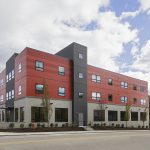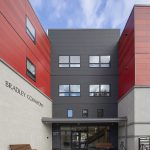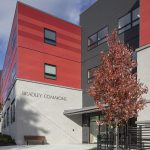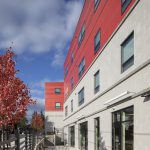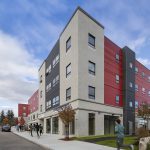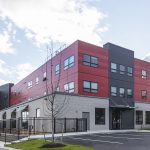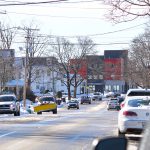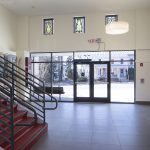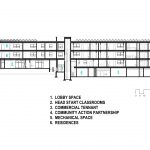Bradley Commons
Project Name
This project is a 61,000 square foot mixed-use building that was completed in June of 2018 with a construction cost of $9.5M. Located in downtown Dover, the site was previously home to a catholic church. Due to excessive structural damage the Diocese decided to sell to a local non-profit workforce housing developer under the conditions that the church be removed and affordable housing be created in its place.
In the downtown business zone, the requirements called for higher density, a minimum of 3 stories, and a 10’ setback from the street. This permitted the building to move closer to the sidewalk and move parking behind to create a positive street edge. The design goal was to respond to the natural curve in the road while integrating into the existing topography, which has a one-story grade change across the site. Working with a tight workforce housing budget, the design uses simple forms and massing. The massing is defined by two blocks with an angled “knuckle” in the center connecting the street with building at grade and transitioning between the differing grades at each end of the building. The connector contains the lobby with vertical circulation and is repeated on each floor creating small community spaces. The fragmented form was used to decrease the visual impact at the street level, while creating a variety of urban spaces seen from different directions. The north view is composed of a warm red façade. From the south, the building edges recreate the strong elements and form that the church once provided at the important intersection.
The first floor has a 7,000 square foot educational wing for Head Start and roughly 10,000 square feet of commercial space with storefronts at street level that open up to an outdoor seating area. The upper floors consist of 39 workforce housing units ranging from 1-3 bedrooms.
The exterior color palette pays tribute to the mill buildings beyond, a cornerstone to Dover’s downtown. The variation of reds was selected for the fiber cement panels that clad the primary forms. A gray stone base to anchor the building. Dark grey panels, highlighting the vertical voids and projections, were inspired by the industrial accents seen throughout town.
The building envelope exceeds the building energy code requirements, making it 30% more efficient than a code compliant structure. It has been designed for solar panels and plan to be installed in the near future.
This project created 39 units of affordable, workforce housing to the community. A mix of 1-3 bedroom units can accommodate anyone from a single person to a larger family. There are two accessible units and 1 hearing impaired unit. All common spaces in the building are accessible. Although the units are designated as affordable, great efforts were made by the design team to make high quality and healthy apartments. Everyone deserves to have a nice and safe place to live. Commercial spaces located on the first floor engage the pedestrian activity of the public sidewalk and reinforce the connection to the community. One of the commercial tenants is Community Action Partnership, which is a community-based organization that offers services to the community, including a food pantry, employment training, and housing services just to name a few. CAP’s Head Start program is located in one of the other commercial spaces. It has 6 classrooms, a commercial Kitchen, and an outdoor playground connected directly to the classrooms. These services are vital to our community and residential tenants. The project is conveniently located downtown with a hospital, downtown square, train station, grocery stores, pharmacy, municipal offices, etc. within a 5-minute walk or bike, and a bus stop is located right out front. A outdoor terrace create public spaces on the site for the community to enjoy. Not only do these attributes strengthen our community, but they also help work towards a sustainable future. Selection of the site is convenient for the tenants and most importantly promotes walking, biking, and use of public transportation. The reuse of an unused site that had fallen to disrepair, was done to integrate into the existing fabric between the industrial downtown and the surrounding residential neighborhood. Working with a tight affordable housing budget, the team focused on creating a building that exceeds code compliancy by 30%. Use of continuous insulation and rainscreen system were incorporated. All of the masonry was sourced from a local company that manufacturers within 20 miles of the project site.


